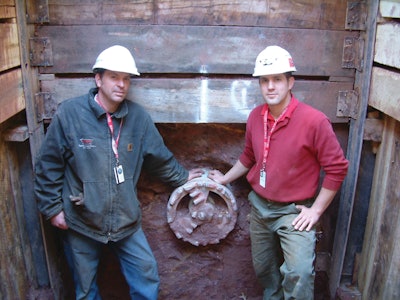
Three Point Construction Inc., Mechanicsville, MD, was contracted by C.J. Miller of Hampsted, MD, as the tunneling subcontractor for a difficult utility project located at the Applied Physics Laboratory at Johns Hopkins University. As part of the work Three Point had to install a 200 lineal foot, 42-in.-diameter steel casing that would accommodate a large duct bank with 24 individual conduits for a new high speed communications system.
Having already completed work on this project gave the contractor a direct knowledge of the soil conditions that would be encountered. At the location of the bore, the conditions were going to be very hard schist with a high content of silica and hard quartz.
"This bore had to be extremely accurate because we have to maintain a minimum distance beneath existing utilities such as two water lines, a gas main, numerous communications duct banks, the main electrical feed to the campus, two causeway footings and the root systems of two oak trees" says Mike Boyd, president of Three Point Construction. "With only inches to spare on either side of the 42-in. steel casing in the receiving pit due to an existing duct bank and building footing, accuracy and precision on line and grade were paramount."
Tough Tool for a Tough Task
Due to the difficult nature of the project, Three Point decided to research trenchless alternatives to conventional auger boring. The company had past experience with Pilot Tube Microtunneling Systems, but also knew they were only designed for use is soft, displaceable soil.
"The pilot tube system would not have penetrated the soil due to its density and the presence of quartz," says Boyd. "In addition, the manual steering and lag head would not have been precise enough to hit the target. We then considered using a tunnel boring attachment as the only other viable alternative."
However, it was ultimately decided that the attachment would not be feasible due to the amount of time for setup and dismantle, as well as the need for a crane for the installation and dismantle process. "The crane required to make the lift would have been costly and there was also no room to set it up", says Boyd.
Running out of ideas, Three Point then contacted ICON Tunnel Systems for possible alternative solutions. Due to the hard soil conditions and extremely tight line and grade tolerances required, ICON recommended the Front Steer Microtunneling System from Bohrtec.
The Front Steer System employs a full cutting face, a pilot tube theodolite guidance system with CCTV monitor and an illuminated LED target directly behind the cutting head, enabling the operator to maintain constant control of line and grade. As the system is advanced in the ground, the operator can see the position of the cutting head with respect to the intended line and grade at all times and make any necessary corrections.
On this particular project, ICON recommended the 16-in.-diameter Front Steer System be used to establish the exact line and grade. The contractor could then follow with his conventional American Augers boring machine to install the 42-in.-diameter steel casing.
Unproven Technology Proves Successful
Although not yet proven in the U.S., the Front Steer Microtunneling System had a successful track record on several European projects and specifications that met its project's needs. As such, Three Point quickly approved the Front Steer System for use on its project.
The Front Steer System was powered and driven through the ground by one of Bohrtec's smaller long frame machines, the BM400L, with 100 tons of jacking force and approximately 14,500 ft.-lbs. of torque. Roughly halfway through the drive, the system encountered two separate locations containing solid quartz rock ranging from 6 to 8 ft. in length each time.
"The Front Steer went right through the rock," says Boyd. "Typically, when you hit rock like that with another boring system, it will completely destroy the head. The Front Steer was in great shape when it arrived at the receiving pit."
The Front Steer arrived at the receiving pit/existing manhole within 1/10 of one inch of line and grade, without disrupting or damaging the various utilities and other obstacles that were near the bore path. Production and excavating rates reached an average of 13.5 feet per hour, keeping Three Point way ahead of schedule.
Three Point then upsized and completed the bore by following the established line and grade with its American Auger boring machine, pushing 42-in. steel casings with large augers inside. The casing bore was finished within a matter of two days, including machine setup. The total project was completed two weeks ahead of schedule and under budget.
"We could not have done this job without Icon," says Boyd. "Once we understood the system and process, we had total confidence that the end result would be a success."


















